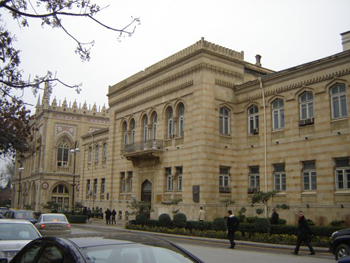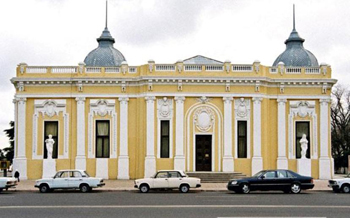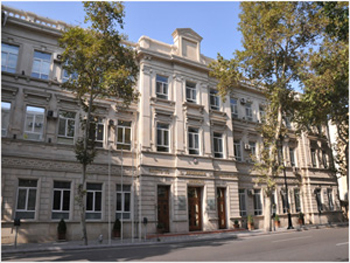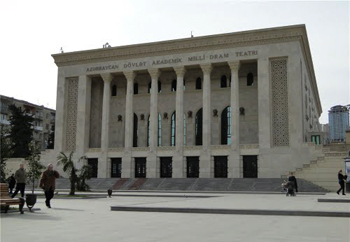Home page
» ARCHITECTURE
» Historical architectural buildings
Historical architectural buildingsSince ancient times as Baku was one the ancient cities not only in the Caucasus, but also in the Middle East for its history, so there were many historical and architectural monuments of different periods. As these monuments combines the eastern and western architectural styles at the highest level, it were always attractive, Baku has become one of the centers of world architecture. To become familiar with these historical and architectural monuments we bring them to your attention. BIBIHEYBAT MOSQUE (1281-1282)  Bibiheybat Mosque religious-architectural monument was built in the XIII century by Shirvan II Farrukhzad ibn Akhsitan. The epitaph is written on the wall of the mosque with historical facts. The inside of magnificent sanctuary of Bibiheybat was built in classic eastern style, entirely of white marble. Sacred verses are engraved on the marble wall with beautiful examples of calligraphy. MULTANI CARAVANSERAI (XIV century)  Multani caravanserai is located in the so-called historical area of Baku, Old City. Caravanserai was named as Multani for the city of Multan, Pakistan. Multani caravanserai was built in the traditional compositional scheme. This kind of caravanserai was used as the shopping center, as well as embassies and communication infrastructure, as one or another region’s market. LITERATURE MUSEUM NAMED AFTER NIZAMI (1860)  The building of the Museum of Literature named after Nizami (formerly Metropol hotel) was built in the style of Gothic architecture on the Project of Mashadi Gasymbay Hajibababayov. In 1914- 15 years after the architect A.A.Nikitin made a number of changes in the project of building the Metropol hotel operated here. TAZABEY BATH (1886)  Tazabey bath architectural building is located in the center of Baku. Bathroom is distinguished with eastern architecture and interior. Tazabey bath meeting the highest standards of taste is one of the health centers in the capital, which is considered as one of the favourite leisure places of city guests. BAKU ARMENIAN CHURCH (1887)  The Armenian Church was the church of the Armenian community lived in Baku. The architect of the building was famous painter Otto Gustavovich’s brother architect of city of Baku and Baku province. MUSEUM OF ART (1888-1895)  The building of the Museum of Fine Arts named after Rustam Mustafayev was built German engineer N.A. von der Nonne for French duke Debur in classical style. In the spectacular architectural monument, the Museum of Fine Arts, which consists of four sections, functions there. THE RAMAZANOV’S BUILDING (1895)  This building, which was owned by the merchant Haji Mammadkerim Ramazanov, was built in national-romantic style. In the past, the home where the family of the Ramazanov lived at the Soviet period was divided among population into separate apartments. HISTORY MUSEUM OF AZERBAIJAN (1895-1901)  This building in which the Azerbaijan History Museum was located was the home of famous philanthropist Haji Zeynalabdin Tagiyev. The building was built under the project of chief architect of Baku city V. Goslavski During the construction of the building a variety of architectural styles had been used. Thus, the symmetric form of the magnificent facade was in Italian renaissance style, cleaning room in French rococo, dining room in Flemish Baroque, bedroom in modern style. BAKU LUTHERAN CHURCH (1896-1899)  Baku Lutheran Church was built in middle of the nineteenth century for religious worship of the German and the Swedish-born people living in Baku at that time.. This building that was architected by 24-year-old German architect Adolf Eichlerthat was one of the pearls of the city\'s most unique architecture. At that time, the Nobel brothers (Emmanuel Nobel) had special attention on the construction of the building. TAGIYEV’S GIRLS SCHOOL (1898-1901)  The project of Tagiyev’s girls’ school building was the work of chief architect of the city in 1892-1904 I. V. Goslavskı. The building was constructed in Gothic style. At that time such a school was not only in Russia, but in the whole Islamic world. On November 5, 1896 the building was officially given for a school of girls. In 1918-1920 Parliament of Azerbaijan Democratic Republic was located in this building. MITROFANOV’S HOUSE (1898-1902)  The owners of the building known as the House of Mitrofanov were Dmitri Mitrofanov and Moses Mikhailov, oil industrialists. D.Mitrofanov from Astarkhan built this building as a private home. The architect of the building was Ioan Edel and French, built in the classic style of French neo-renaissance. During the Azerbaijan Democratic Republic the Embassy of France was located here. BAKU CITY EXECUTIVE POWER BUILDING (1900-1904)  The architect of the building of the Baku City Executive Power Polish origin I.V.Goslavsky had used Baroque motifs in the construction of the building. To decorate the facade of the building, red-colored decorative brick and marble was imported from Italy. With adherence to classical composition scheme the architect symmetrically constructed building of the Duma. The arms of the Baku city have been preserved until now on the building. THE AIBEYOV’S HOUSE (BEGINNING OF XX CENTURY)  The building named as The Alibeyov’s house was built in the classical and aesthetic style. Russian architect Nikolai Prakopev projected the Alibeyovs’ house. The building was built in the early twentieth century. ASHURBEYOV’S HOUSE (1904)  The building of the Ashurbeyov’s was built for the son of millionaire Teymur Ashurbeyov’s son Balabey as a wedding gift. The building built in Baroque style was last work of I.V. Goslavski. TAZAPIR MOSQUE (1905)  Tazapir mosque is a building in the East, which has a unique beauty. This monument is considered a religious center not only in Azerbaijan but all the Caucasus. Tazapir mosque is sanctuary like architectural monument. The mosque was built on money of Nabat Ashurbeyli-Rzayeva with project of Ziverbey Ahmedbeyov. ISMAILIYYE (1907-1913)  Ismailiyye building was built by Baku millionaire Musa Nagiyev in memory of his son died at young age. The designer of the palace built in Venice Gottic style was Polish I.K. Ploshko. The idea of independence of Azerbaijan was for the first time sounded in this building. In March 1918 events the building was burnt down by the Armenians. AZERBAIJAN STATE PUPPET THEATRE (1910)  Azerbaijan State Puppet Theatre was built in Baroque-style. The architect of this historic building was K.Ploshko. Ventilation system for the first time in a public place was used in this building in Baku. The building was built as a cinema and began to operate under the name of Phenomenon cinematography. It was given to Puppet Theatre in 1980. ACADEMIC OPERA AND BALLET THEATRE (1910-1911)  Academic Opera and Ballet Theatre was designed by N.G. Bayev. Millionaire Mayilov built this building specifically for opera and theatre. The building was built in the Gothic style for a period of ten months and the theatre named at Mayilov brothers. Since 1959, the building was named as Academic Opera and Ballet Theatre. AZERBAIJAN STATE PHILARMONY (1910-1912)  The building of the Azerbaijan State Philharmony was built as a project building of social gatherings (Public gatherings summer house). The architectural design of the building was done as the famous casino in Monte Carlo. THE PALACE OF WEDDING (1911-1912)  Wedding Palace (Murtuza Mukhtarov’s House) is a palace built for wife of millionaire Murtuza Mukhtarov, Lisa of a Jewish origin. The Project author of the Palace built in French Gothic style is the Polish-born architect Joseph Ploshko. So far, only in the Russian press 50 materials about the history of the building have been published. ISA BEY HAJINSKI’S HOUSE (1912)  Isa Bey Hajınski’s house was built within 3 months in a bet with one of the millionaires of Baku. Unknown famous Italian architect built the building in Gothic, Baroque and modern styles. This is the first high-rise building in the classical style in Baku. BAKU SCHOOL OF COMMERCE (1912)  Baku Commercial School was built with the Project of the architect G.M.Tert-Mikelov. The technical, commercial, financial, and so sciences were taught. This building now operates as an educational institution. GOVERNMENT HOUSE (1924-1952)  Government House is the palace-style building. The palace was built in the Gothic style of architecture. The part of building construction materials used in the construction was imported from abroad. Vladimir Munts and Lev Rudnev were the architects of the building. BESHMARTABA (1929)  Beshmartaba is the first modern five-storey building constructed in Baku. The building is located in the center of Baku – at “Fuzuli square, at intersection of str Jabbarli and str Fuzuli. The area of location of building still is known as Beshmartaba. THE MUSEUM CENTER (1960)  The building of Museum center was constructed on the basis of the project of architect Hasan Majidov. This building is located in the following museums: - Azerbaijan State Museum of Carpet and Folk Applied Art - Azerbaijan State Museum of Theatre named after J.Jabbarly. - Azerbaijan Museum of Independence - Azerbaijan State Museum of History of Religion HEYDAR ALIYEV PALACE (1972)  The architects of the palace, built in the modern architectural structure were Vadim Shulqin, Eduard Melkhisedekov, Vitali Faynstein. The Palace is designed for holding highest state and cultural activities. Since March 10, 2004 the palace was named as Heydar Aliyev Palace. GULUSTAN PALACE (1979-1980)  Gulistan Palace was built in a modern style. This building combines exact geometric silhouette, original, well-remembered, functional aesthetic influence and its architects are Nazim Amirkhanov and Hafiz Hajibeyov. The architects using the motivation of traditional architecture of Azerbaijan creatively could achieve the building’s effect, light and shadow effect NIZAMI CINEMA CENTER (1930-1934)  Nizami cinema was built in the classical style. The architects of the building were S.Dadashov and Mikhail Huseynov. It is largest cinema system in Baku city. The first time this center of art operated under the name Badaye cinema. BAKU ACADEMY OF MUSIC (1885)  The foundation of Baku Music Academy named after U.Hajibeyli was built in the classical style. The building was later renovated by the architect Mikhail Huseynov. PRESIDENTIAL PALACE (1977-1986)  Presidential Palace is a building constructed in modern style with marble and granite covers and is of twelve storeyed. Modern style building was built under design of Fuad Orujov (project manager), Tahir Allahverdiyev (architect) and Madat Khalafov (designer). The main architectural feature of the Presidential Palace is simplicity and grandeur. AZERBAIJAN NATIONAL LIBRARY NAMED AFTER M.F.AKHUNDOV (1961)  The building was built in the synthesis of modern and classic style. Architectural design of the building as a historical monument was provided by Mikhail Huseynov . The building was built specially as the National Library building. The building is known as the largest library in the Caucasus. AZERBAIJAN STATE YOUNG SPECTATORS THEATER (1969)  The building was constructed in 1969 and, in 1988 it was re-established in accordance with the project of architect Senan Salamzade. Facade of the building is covered with spider type glass. AZERBAIJAN STATE MUSICAL COMEDY THEATRE (1883)  Haji Zeynalabdin Tagiyev built this building on the bases of his grain storage. Construction was headed by engineer-architect Lemkul. The building was burnt down a few times. Academic National Drama Theatre functioned in this building from 17 January 1922 until August 1960. Among the people it is known as City Theater. TAGIYEV’S PASSAGE (1898)  I is two-storey building known as the former department store, the shopping center (new Bum). It was built by H.Z Tagiyev. The small play center was in the building, built in the classical style. HASHIMOV’S HOUSE (CONSTITUTIONAL COURT) (THE END OF THE XIX CENTURY)  Building near the Gosha Gala in the Ganjlik square was a house of millionaire Hajibaba Hashımov. Building was built in the classical style four-storey facade. The third floor is a performance hall. In Soviet times it was called as House of Political Education . LANDMARK-BAKU (1909)  The building of Landmark-Baku is located in Baku at the intersection of Azadliq Avenue and Nizami street. The building was built in 1909 in classical style. UNIVERSITY OF ECONOMICS (beginning of XX century)  The building was formerly Baku I Realniy School’s building. It was built by millionaire Musa Nagiyev. At present, the building is the main building of the Azerbaijan State Economic University. The building was built in the classical style has been repaired several times. OIL COMPANY BUILDING (1893)  The building of State Oil Company is among the oldest buildings in the city of Baku, and it attracts special attention with its grandeur and beauty. Building Project on was approved on May 25, 1893. The facade of the French Renaissance style was faced to the western side of the coast. The building built towards Azneft square and consisted of comfortable apartments was of great importance built in the design of the city. NATIONAL ACADEMY OF SCIENCES (60th years of XX century)  Azerbaijan National Academy of Sciences and a large part of its research institutes in the 60s of the last century , was built by the project of architect Mikhail Huseynov. It combines modern architectural style of the classic architectural features. THE MINISTRY OF COMMUNICATION AND IT OF AZERBAIJAN REPUBLIC  The building of the Ministry of Communications and Information Technologies of the Republic of Azerbaijan was built by Baku millionaire Musa Nagiyev. The building was built in the classical style. AZERBAIJAN STATE ACADEMIC NATIONAL DRAMA THEATRE (1960)  Azerbaijan State Academic National Drama Theatre was built in classic and modern styles. The building was built as a theater building.
|
